Hayes Dominion T4 Brakes
Blister’s Measured Weight: 257 and 281 g (uncut hoses, no adapters or rotors)
MSRP: $325 per brake, w/o rotors or adapters
Bolted to: Nicolai G1
Reviewer: 6’, 175 lbs / 183 cm, 79.4 kg
Test Locations: Washington
Test Duration: 4 months

Intro
When I reviewed them a couple of years ago, the Hayes Dominion A4 brakes became my clear favorite option on the market at that point. The combination of very good power, extremely light free stroke, firm-ish bite point, and excellent consistency that they offer won me over, and while there are a few newer worthy contenders that have cropped up in the years since — the Hope Tech 4 V4 first and foremost — I’m still a huge fan of the Dominion A4s.
But now the Dominion A4 has a new, lighter sibling — the Dominion T4 — and on paper, the T4 is essentially just a lighter, more expensive A4. But does that weight savings come with any notable performance downsides or reliability issues? I was curious to find out. And having now spent a whole lot of time on the Dominion T4s, including a bunch of A-Bing against the A4 variant, the T4s are very, very close to just being a lighter A4 — with a couple of slight caveats.
Design
Most of the design details of the Dominion T4s are shared with their A4 siblings. Both use a symmetric master cylinder assembly (i.e., one that can be run on either side of the bar) with an identical overall layout and a four-piston caliper with matching 17 mm pistons all around. They both use DOT fluid, a two-bolt split clamp for the lever assembly, and proprietary brake pads (with a shape shared between the A4 and T4, and available in a number of aftermarket varieties, including from Galfer).
Hayes’ ingenious “Crosshair” caliper alignment system also carries over. It’s just a set screw on the outer side of each mounting tab that lets you fine-tune the caliper alignment by pushing the caliper inboard with one hand, then adjusting the set screws so that they push against the caliper mounting bolts and set the caliper alignment. You can see the set screws in the photo below to get an idea of how it all goes together.
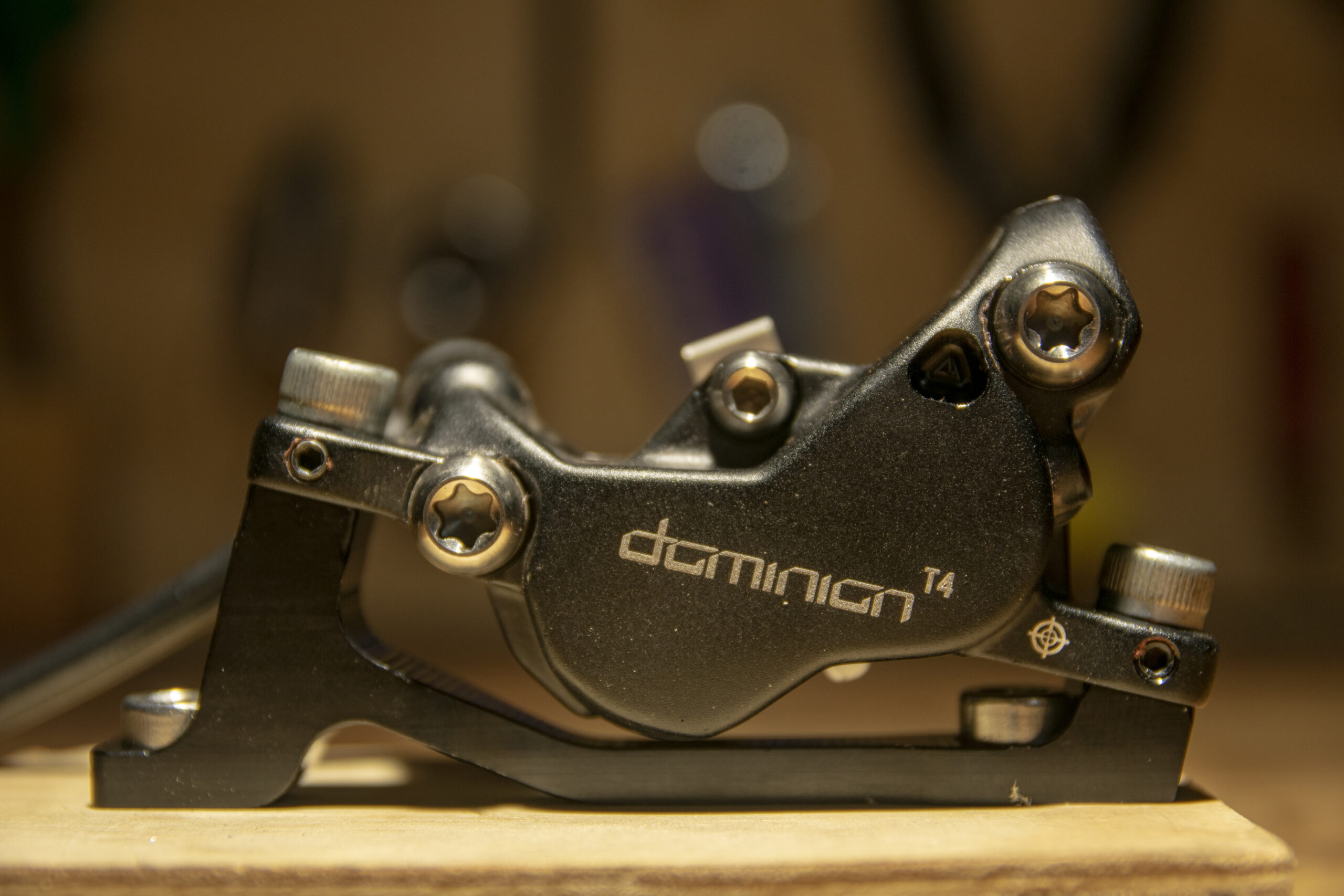
It’s not a 100% perfect system because you do need to fiddle with the two screws in alternating order to get both ends of the caliper lined up nicely (if you make a big adjustment to one side it has a noticeable impact on the other) but it still works really well to help dial things in (and you don’t have to use it if you don’t want to). The pad clearance on the T4s is definitely on the tighter side, as tends to be the case with the most powerful brakes on the market, but the Crosshair system makes aligning the Dominions easier than most.
Another interesting feature shared across all versions of the Dominion brakes is the dual bleed port configuration on the caliper. In short, there’s a port on each half of the caliper body, which you can (but don’t have to) use separately to help get out any tricky air bubbles should you need to. I’ve generally found the Dominions to be easy to bleed with a normal procedure and haven’t needed to resort to using both of the caliper bleed ports, but it’s nice to have the option, and I don’t see any real downside to having it there.

The Dominion T4s accomplish their weight savings by swapping in a carbon fiber lever blade (made by Hayes’ sister company, Reynolds), swapping in titanium hardware throughout (including rotor and caliper mounting bolts), and machining away a bit of excess material from the caliper. The Dominion T4s also forgo the tool-free reach adjustment of the A4 version (with a tooled adjuster in its place) to carve out a few more grams, and also add a lighter composite reservoir cover. Finally, the stock brake pads on the Dominion T4 use an aluminum backing plate (in lieu of the steel one on the A4 pads), though the two share a pad shape so you can use the pads from one in the other. All of that adds up to about a 45-gram weight savings per brake as compared to the Dominion A4.
The other notable difference between the Dominion A4 and T4 is that the latter forgoes the “Small Finger Lever” option that’s offered on the A4; the T4 lever shape mirrors that of the standard lever on the A4, but if you want the SFL you’re stuck with the A4.
On the Trail
I’ve already talked a lot about how much I like the Dominion A4, with its combination of exceedingly light lever feel through the free stroke, a firm, solid bite point, very good outright power, and excellent reliability and consistency. The short version here is that everything I like about the Dominion A4 carries over to the T4 version. If I really concentrate I can maybe detect a tiny bit more flex in the carbon fiber lever blade making the bite point on the T4s feel very, very slightly softer, but there’s hardly anything in it, and the super light free stroke, overall lever feel, and very good power are pretty much identical. The T4s are substantially lighter (at least as a percentage of their total weight) for the weight weenies out there, but I can’t honestly say that the weight savings are really noticeable on the trail, either. So big picture, I think it’s fair to think of the Dominion T4s as a lighter Dominion A4 for the folks who really want that, but that the standard A4 is probably the way to go for most people.
That’s not because there’s anything the least bit wrong with the T4s. I had wondered if they’d make any noteworthy compromises to braking performance in search of weight savings, but I really can’t detect any — I just don’t think that most people will really get much out of spending an extra $150 per pair to save less than 100 grams. But if you want to (or really care about the cosmetic finish — the T4s do look better than the A4s — they’re here for you).
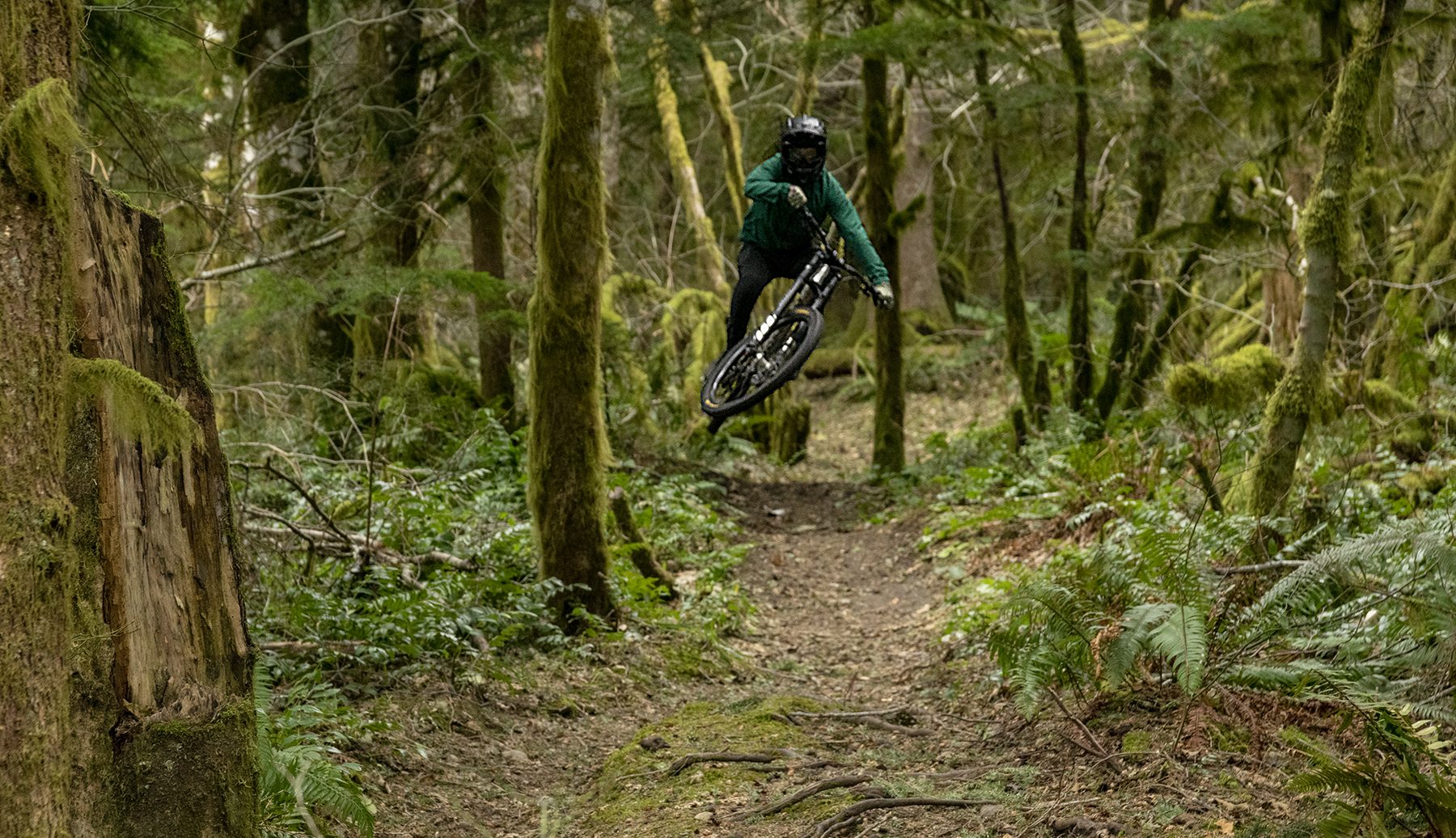
I was also curious to find out if the aluminum-backed brake pads that come stock on the T4s would make any difference when it comes to brake fade since the aluminum backing material is theoretically more conductive than the steel one used on the A4 pads (and most other ones). But honestly, I don’t think I can tell a difference there, either (and the A4 and T4 pads are interchangeable anyway — the shape is the same between the two).
That said, there are a couple of (very) slight differences between the two beyond just weight. The main one is the feel of the lever blade itself. While I’d be hard-pressed to detect any differences in the action of the levers (i.e., how they feel and move when you squeeze them) the carbon lever blade on the T4 does feel slightly thinner and lacks the dimples of the A4 lever blade. Their actual cross-section is essentially the same thickness, so my hunch is that the difference comes down to variations in radii (or maybe even just the lack of dimples on the T4) but it’s there.
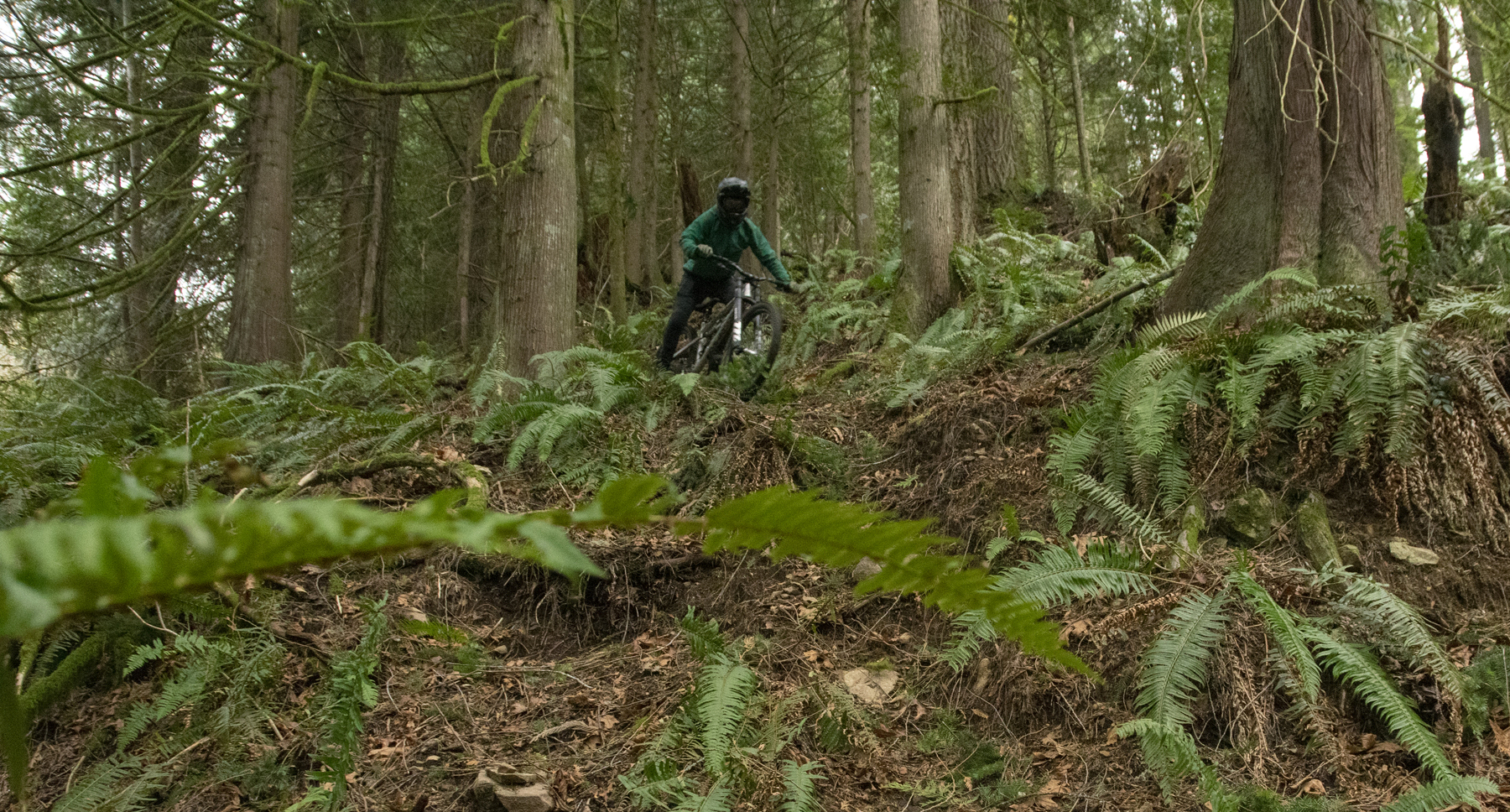
Rotors & Rotor Sizes
I tested the Dominion T4s with both Hayes’ 203 mm D-Series rotors on both ends, as well as a 223 mm front / 203 mm rear Galfer Shark Rotor package. The Hayes rotors work nicely, but I have come to prefer a bigger front rotor on 29er Enduro and DH bikes for more power and fade resistance than the 203 mm top end of the Hayes rotors at present. Happily, a 220 mm version of the D-Series rotor is in the works (though we’ve yet to try them) so there will be an option directly from Hayes soon.
The 2 mm thickness of the Shark rotors does seem to be about the absolute maximum that the Dominion calipers can accommodate with new pads, and it can be a little tough to get them 100% rub-free right out of the gate; with a ride or two to wear the pads down fractionally, it’s no longer an issue. The D-Series rotors are only very fractionally thinner at 1.95 mm but that does seem to be enough to make a (minute) difference.
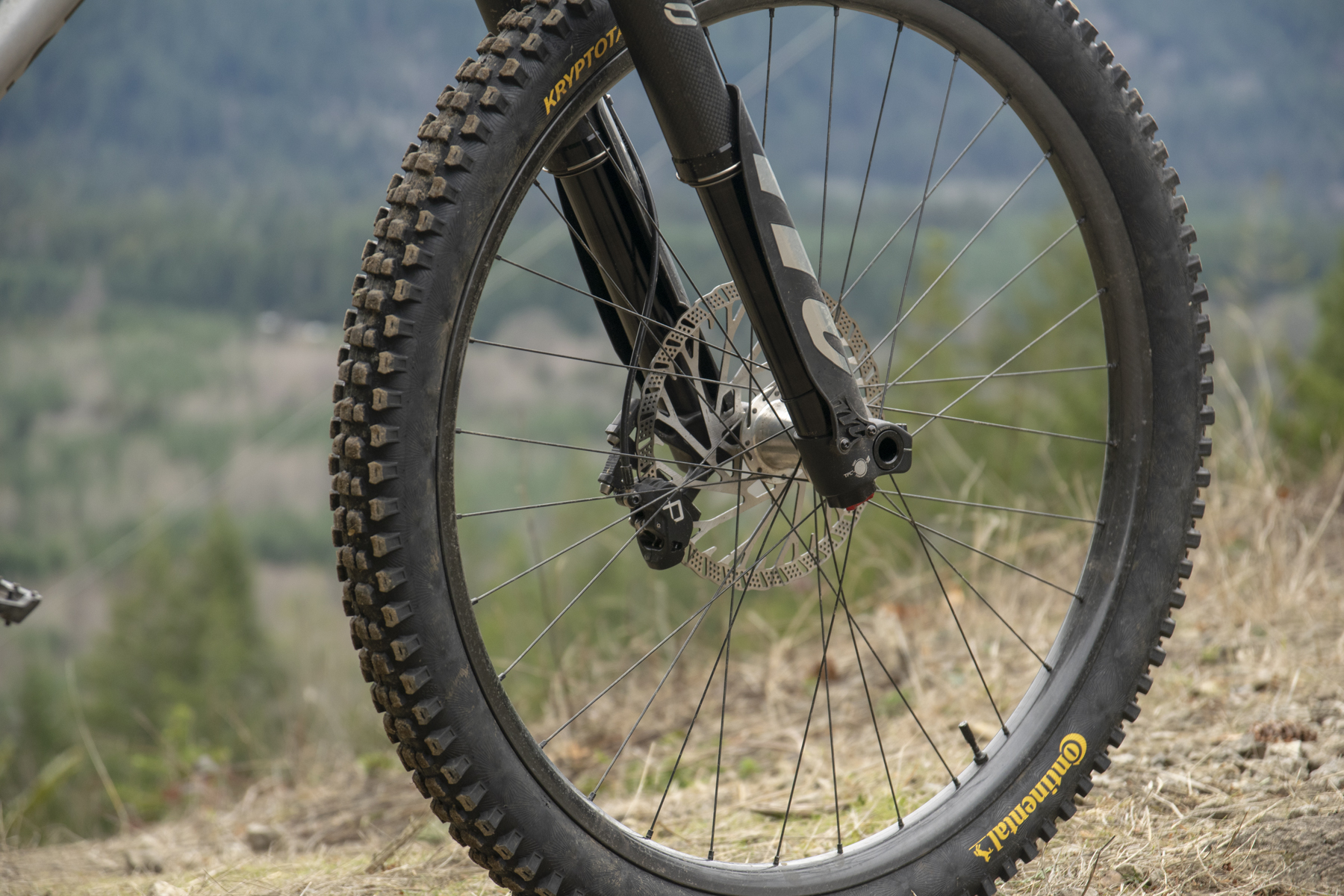
Brake Pads
The Dominion T4s come with the same resin pads that are supplied with brake pads that use the same “T106” semi-metallic compound as used in the Dominion A4, but with an aluminum backing plate in place of the standard steel one to save a few grams. The “T100” full-metallic pads from the Dominion A4 can also be used, but aren’t available with the aluminum backing plate.
The stock T106 pads are quiet and consistent but don’t work especially well in wet conditions and can fade at very high temperatures; the T100s are harder-wearing, fare better in the wet, and are harder to get to fade, but are also nosier and don’t work as well when relatively cool, and take more hard braking to get up to operating temperature. The tradeoffs are fairly typical of those between the metallic and semi-metallic (often labeled as “organic”) offerings in most OE brake pad options, and Hayes’ offerings are solid ones. The T100 metallic pads are a bit noisy, especially when really hot, but overall work well.
Maintenance
I haven’t had to bleed the Dominion T4s since I installed them and given that my original pair of Dominion A4s are coming up on three years of regular use with only pad replacements and a few bleeds (necessitated more by frame swaps and internal routing than any major performance issues) I’ve got similarly high hopes for the Dominion T4s. The stock resin pads are somewhat short-lived, especially in wet conditions, but the metallic ones are much harder wearing and there are a variety of good aftermarket options available (I’m still a huge fan of Galfer’s Pro ones).
If I absolutely have to nitpick, swapping pads on the Dominions is a little fiddly since they bottom load and need to be pushed inward to drop out rather than pulling straight down. That means that you need to remove the wheel to get them out at a minimum and have to take the caliper off the frame or fork to do a pad swap in a lot of cases. That said, the arrangement does nicely serve as a failsafe for losing the pads if the retaining bolt rattles out (there’s no way for them to come out with a rotor between them) so it’s very arguably a solid safety feature, and I tend to prefer to remove the caliper to do a full piston reset when swapping pads anyway.
But overall, the Dominion brakes (A4s or T4s) have been extremely consistent, reliable, and easy to work on in my experience. They’re very easy to get a good bleed on but also haven’t needed much attention beyond replacing pads and refreshing the brake fluid from time to time.
The only (minor) issue that cropped up is that I had the reach adjustment migrate a tiny bit over time on one of the T4 levers. It never moved so abruptly as to cause an issue mid-run or anything like that, but I did notice the reach becoming very slightly shorter over the course of several rides. Adding a little blue thread locker to the adjustment screw took care of it. (The brakes do come with some thread locker pre-installed; the factory application was apparently just better on my right brake than the left, I guess. In any case, it was an exceedingly easy fix.)
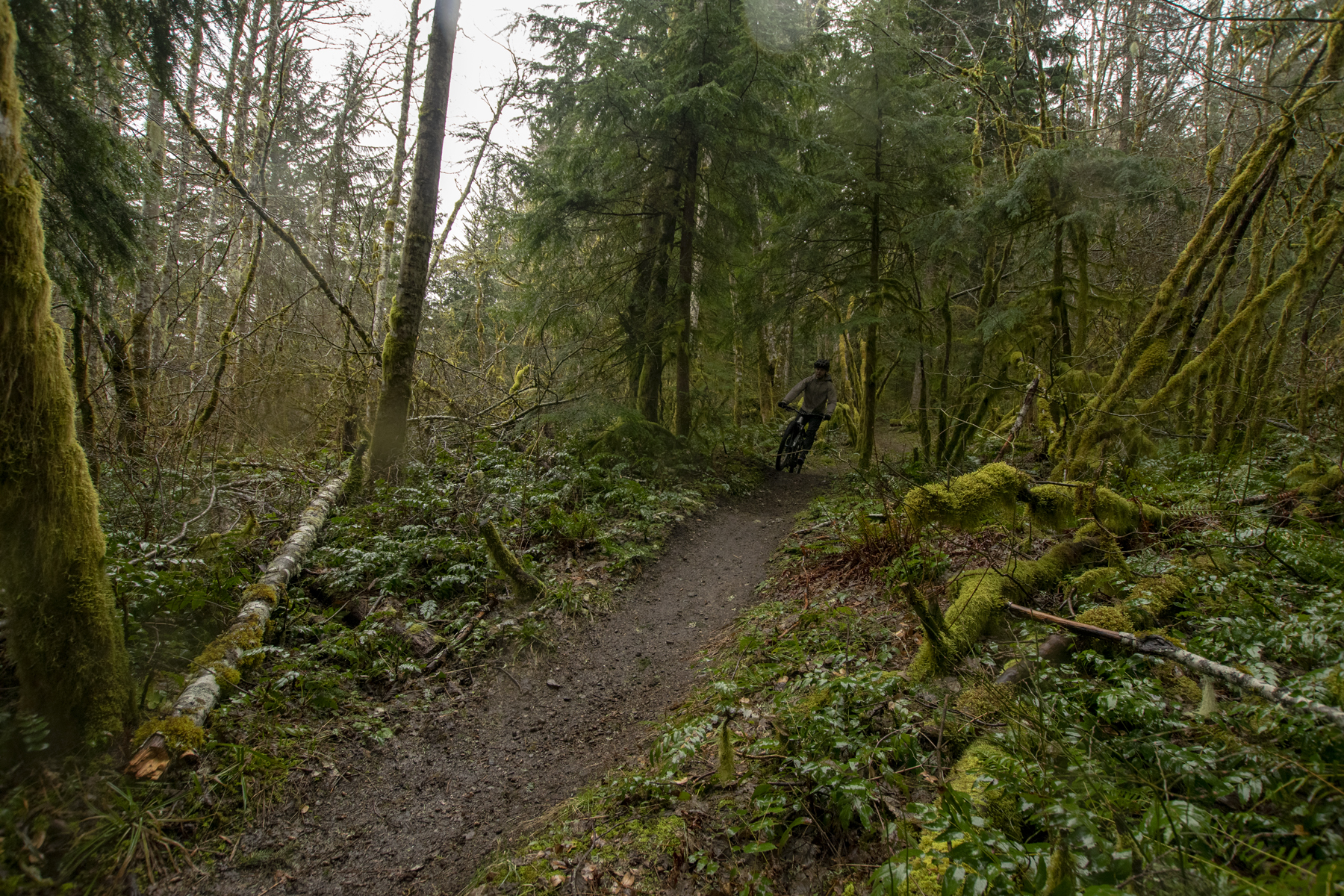
Bottom Line
I went into my testing of the Dominion T4 wondering if it’d be a lighter Dominion A4 that keeps all of the performance of its heavier, less-expensive counterpart or if the weight savings would compromise the T4s in some way, and I’m pleased to say that it’s the former — it’s accurate to think of the T4s as a lighter, fancier version of the Dominion A4.
The thing is, while that is true, I can’t help but feel like it sells the Dominion T4 a little short — because the Dominion A4 is one of the best gravity brakes on the market, and a lighter version that keeps all of the performance of the original is great. Will the extra price be worth it for everyone? Definitely not. But both versions of the four-piston Dominion family are excellent brakes, and it’s between you and your bank account if you want to spend the extra money to save some weight.
And for a whole lot more on how both the Dominion T4 and A4 stack up against a whole bunch of the top brakes on the market, check out our recent MTB brake shootout.

“The pad clearance on the T4s is definitely on the tighter side”
Kills it for me. Personal preference, I know, but this factor is huge to me.
The tight clearance is definitely not ideal, but it’s also the price to be paid for having a lot of power and a not-huge lever throw. The greater the clearance, the more lever throw you’re going to have to move the pistons through that space, and if you combine that with a high-leverage, powerful brake you have to compromise somewhere. I’ll take tight-ish clearance (within reason) and I think the balance the Dominions strike is a pretty good one.
My 2 piston Dominion A2 brakes also show a bit of the “reach adjustment migrate a tiny bit over time” mentioned in David’s review above. The A2 has similar tight pad clearance making perfect scrape-free adjustment tricky (not always 100% given my skill/patience level). Both are minor issues because when riding the Dominion A2 brakes are terrific XC / light trail brakes if your descents aren’t overly long and brake-scorching.
-Andy